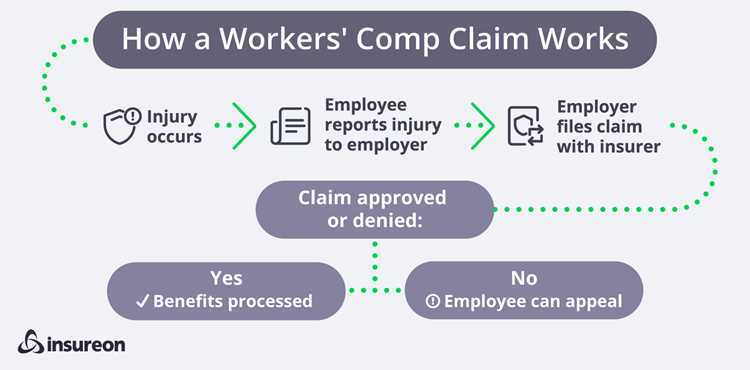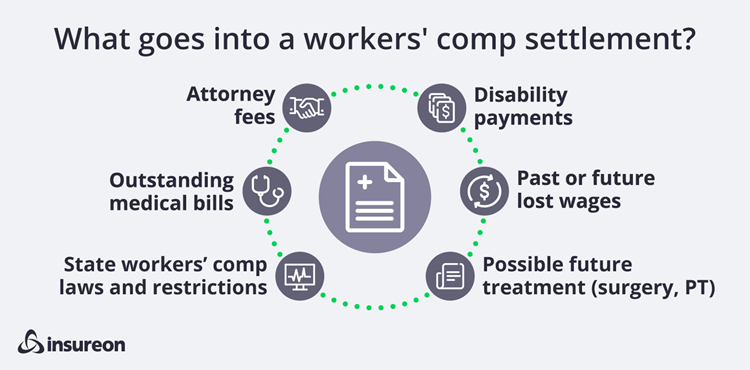How Do You Know if You Get Workman
How do workers' bounty settlements work? What you lot demand to know
Workers' comp settlements can be a simple matter – or a stressful courtroom boxing. Learn what's involved, how settlements are calculated, and ways to attain an agreement.

Workplace accidents and injuries are an unfortunate fact of business life. And an expensive one.
The U.S. Bureau of Labor Statistics reported ii.eight one thousand thousand nonfatal workplace illnesses or injuries by private employers in 2019. And each year, U.S. companies spend nearly $62 billion on lost-time workplace injuries.
To protect employers and workers from the financial risks of workplace injuries, nearly every state requires businesses with employees to carry workers' compensation insurance. This no-mistake coverage protects you from employee lawsuits regarding injuries. Information technology too protects injured workers by covering costs such as:
- Injury-related medical bills
- A portion of lost wages
- Inability benefits
Filing a workers' comp merits can be simple. Just settling one is often a different story.
When y'all and your injured worker sympathize workers' comp settlements, the process will exist smoother for everyone. To learn more, let's take a look at:
- The basic claims procedure
- What'southward involved in the settlement procedure
- How settlements are calculated
- Why some cases stop up in court and what to expect
How the workers' comp claim process works
Employers and employees each play an important role in the workers' comp claim process.
When a worker suffers a work-related injury, they must quickly report information technology to their employer or gamble losing benefits. States have various deadlines for reporting a workers' comp injury, ranging anywhere from 72 hours to ii years. Most typically require a report within xxx days to start the workers' comp claims process.
As the employer, yous should follow these steps once y'all're told an employee was hurt:
- Get the employee medical attending. If you learn of an injury right away, help the employee receive the proper care.
- Investigate the blow. You take a duty to document what happened and identify possible safety issues. This may include detailing witness statements and taking pictures.
- File a claim. You're unremarkably responsible for filing a workers' comp claim with your insurance provider. Rules vary, but y'all may too demand to submit documentation to the state workers' comp board.
Once a merits is filed, the workers' comp insurance company will either approve or deny it. You lot may be involved if an investigation into where and how the injury happened is needed. The insurance company may also review medical files and blow reports.

What happens when a claim is denied?
Insurers normally deny claims for injuries that:
- Are self-inflicted
- Are caused by fighting or horseplay
- Occurred during an employee's work commute
- Occurred while under the influence of alcohol or drugs, violating company rules, or committing a crime
The injured worker may appeal the denial and possibly rent an attorney to correspond them. The appeal process typically involves an authoritative hearing. You can learn more than about the hearing process in the role of workers' comp hearings below.
What happens when a claim is approved?
If the workers' bounty claim is approved, the insurance visitor will pay for any medical expenses related to the injury.
While an employee is unable to work, they volition receive a portion of their wages equally a weekly benefit. Your workers' comp insurer will besides pay these temporary total disability benefits (typically 2-thirds of the employee's regular pay).
Temporary total disability benefits terminate after an employee returns to work – fifty-fifty if they still accept an open merits. For instance, let'due south say a worker trips and sprains their talocrural joint on the way to go coffee in the part break room. They're able to work, just they keep to receive physical therapy.
The insurance company would keep to pay for any medical bills related to the claim. Because the employee's dorsum at work, their temporary disability benefits would stop.
Some employers also develop return-to-piece of work programs to help get their injured employees back on the job. These programs come with meaning benefits.
If an employee refuses an offering of light or modified duty work by an employer, in some states they may lose additional benefits.
What is a return to work program?
Your goal should be to become your injured worker healthy and back on the chore equally rapidly equally possible. A render-to-work programme can assist.
This option typically lets an employee perform light or modified work that'southward less taxing than their normal responsibilities. Be sure to formally certificate your plan.
For employees, benefits may include:
- Improved morale: Getting back in the saddle and connecting with people can assist with recovery.
- Maintaining skills: Abilities tin can decline the longer a worker is away from the task.
- Financial security: Workers who return to work usually end upwards making more than than the partial wages they receive while off piece of work.
For you, the advantages can include:
- Employee retention: The longer employees are off work, the less likely they'll return. Studies take found employees out of work for 6 months or longer have less than a 50% chance of ever returning. An RTW program can assist you lot agree on to valuable workers.
- Reduced employment costs: Getting an employee back to work helps avert the costs of hiring and training temporary replacements.
- Lower workers' comp costs: The faster employees return to work, the lower your claim costs. This helps keep futurity premium rates down.
- Reduced litigation: Render to work programs allow for open up communication and show employees y'all intendance, decreasing litigation costs.
Be sure your programme encourages injured workers to return to work when they're gear up, and doesn't pressure level them to come up back before they're able. Leave it to the medical professionals to brand those decisions.
If an employee refuses an offer of light or modified duty piece of work past an employer, in some states they may lose boosted benefits. That's why information technology's disquisitional for workers and employers to know employees' rights in their country.
Washed right, a return-to-work programme can help pave the mode for a smooth claim resolution.
Protect your business and employees with workers' comp insurance
How workers' comp settlements are reached
If a worker is fully recovered and back to piece of work with no outstanding bills or unpaid benefits, the merits tin can merely exist closed.
In many states, closing a merits involves a settlement negotiated betwixt the insurer and the injured worker, often through their attorney. (If the parties can't reach an agreement, a approximate will need to make up one's mind after a hearing, described in item in the side by side section.)
The settlement process typically begins with an offer from the insurance visitor and employer. This may include payment for unpaid benefits or medical bills, every bit well as costs of hereafter treatment. If an injury leaves a worker permanently dumb, they may also be entitled to a disability laurels to compensate them.
A piece of work injury settlement can be either a lump sum or a structured payment plan:
- Lump sum payment: The employee receives a one-time payment for all medical costs and benefits under the claim. Depending on the state, they may have to agree not to seek any future reimbursement for the injury.
- Structured payment: The employee will receive regular payments over a specified menses of time. They may include a carve up medical account to pay for future medical care.

Before a settlement is reached, the employee and their chaser calculate what they think the workers' comp payout should exist. It should be enough to cover previous medical intendance and future medical costs. The settlement should take into account:
- Balances on medical bills, including ambulance rides
- The likelihood of future treatments, such every bit surgery or physical therapy
- Lost wages or hereafter wage loss
- Temporary or permanent disability payments
- Chaser fees
- State workers' comp laws and restrictions
Once the calculation is finalized, the employee and their attorney will negotiate with the insurance company. Typically the final settlement is a compromise between the 2 parties.
In many states, a workers' compensation judge must review the proposed settlement earlier it's finalized. The judge will consider whether it's fair to the employee, but it's ever helpful for the injured worker to have legal representation to protect their interests.
Your role is minimal during settlement negotiations. Yet, keep the lines of advice open and stay updated on progress.
Settlements may accept weeks or months to hammer out. During this time, be sure your employees know their return-to-piece of work options. Injured workers who are kept informed and know their options are less probable to sue.
If the insurer and the employee can't attain a settlement, then they're probably headed to court for a hearing. And that can exist a bit of a run a risk for both sides.
Taking a workers' comp case to trial can be risky for both insurers and injured workers. A approximate may order a settlement that's far below or above what either side was offer.
The part of workers' comp hearings
Workers' comp claims can state in court for two main reasons:
- If an injured worker has their claim denied, they have the right to appeal. States differ, merely if the insurer yet denies the claim, the injured worker can asking an appeal hearing earlier a judge to consider their workers' compensation case.
- For approved claims, if the parties don't settle or aren't willing to negotiate, the employee and their chaser may opt to let the court determine.
A workers' comp trial to determine a fair settlement is normally called a workers' comp hearing or lawsuit. At a hearing, both sides present their position.
The judge evaluates the case and will decide on an appropriate settlement amount. The insurance company must follow the judge's order to pay the claim, and the settlement is complete.
Taking a workers' comp case to trial can exist risky for both insurers and injured workers. A judge may gild a settlement that'southward far beneath or above what either side was offering.
You'll have little interest in the hearing process. Your master responsibleness is providing each side with whatever necessary information.
Ideally, the goal is to resolve claims without a bitter court fight. The most important thing is to rapidly get an injured worker back to wellness and back on the job whenever possible – for everyone's do good.
Edifice trust and cooperation can become a long manner to encouraging a settlement and avoiding litigation.
Complete Insureon's piece of cake online application today to compare quotes for business insurance from top-rated U.S. carriers. In one case you notice the correct policy for your modest business, y'all can begin coverage in less than 24 hours.
Source: https://www.insureon.com/blog/how-do-workers-comp-settlements-work
0 Response to "How Do You Know if You Get Workman"
Post a Comment